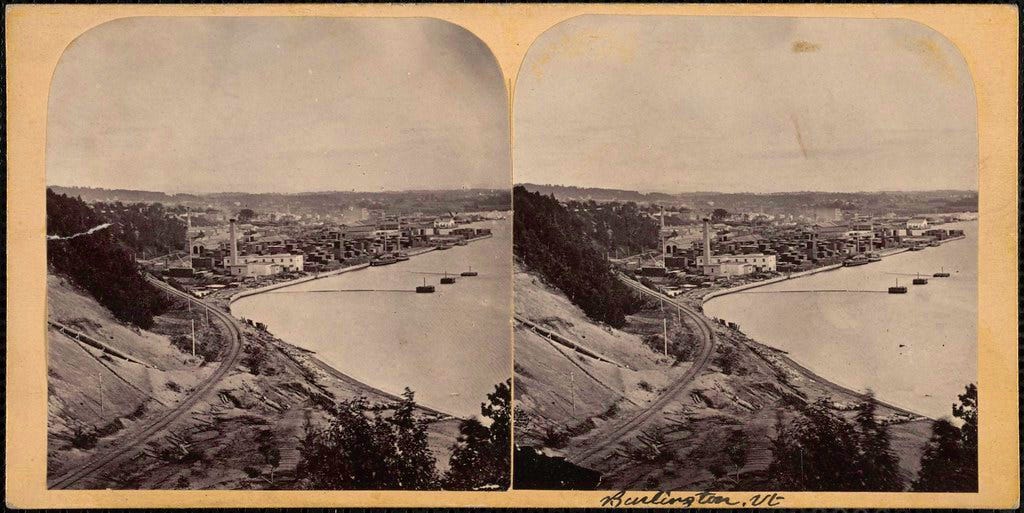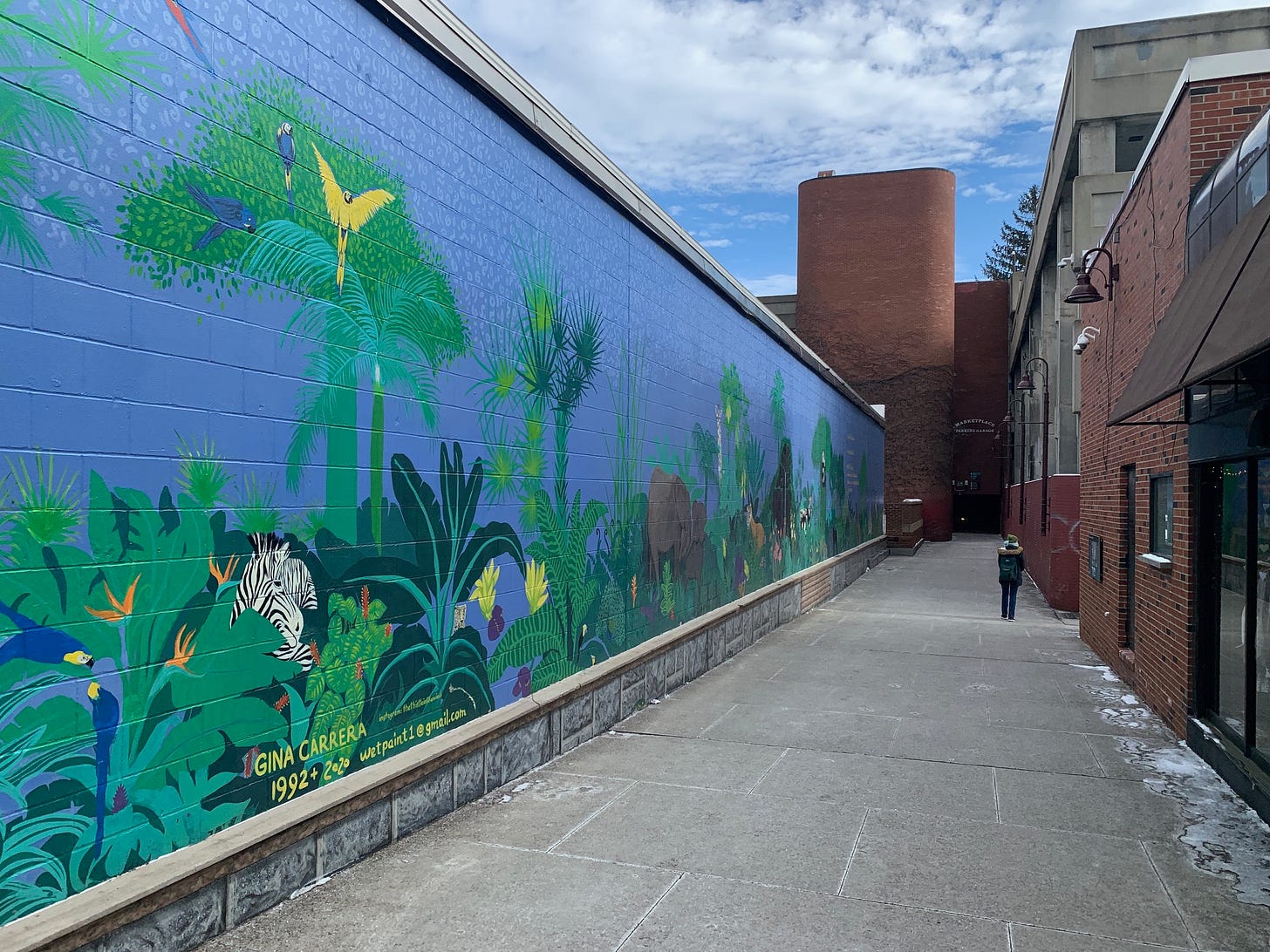As a New Englander, I’m jealous of Minneapolis-Saint Paul, Dallas-Fort Worth, and other cities that happen to be twins. I realize that we do have cities buffered by several towns, but there’s just something about the dichotomy of two cities that feels perfect for a region as historically repressed as New England. Take Boston, for instance. Imagine if there was a singular city on the other side of the Charles River called, uh…Nutfield. Let’s go with that. Now picture this: In the evening, when Boston goes to sleep, Nutfield wakes up and offers all sorts of nocturnal recreation. Not just bars, but basement raves, impromptu movie screenings in alleyways, sex parties, poetry readings, and art openings where the actual doors don’t open until 11pm. You could go to work at a hospital or a university in Boston by day, cross the river at dusk, and become another person in Nutfield after dark. It would be the civic equivalent of Jekyll and Hyde. A dual life.
By my estimation, the closest thing New England has to a pair of twin cities are Burlington and Winooski—the cosmopolitan jewels of northwestern Vermont. Now, we’re not talking about twin cities of equal heft. Burlington has 44,781 residents while Winooski only has 8,330. But the two cities are densely-populated outliers in a region of small towns and sprawl. They’re pretty much connected to each other, with the Winooski River serving as the buffer. And they offer their own distinct vibes. Burlington is a center of commerce teeming with students, gearheads, and folks who’ve spent a lot of money to come here from afar and get their mitts on a draft Heady Topper. Winooski, by contrast, plays like a Springsteen acoustic deep cut. The city center is smaller and less polished. Everything here is humbled by the nearby roar of Winooski Falls. But it’s no less savory. It’s a classic Vermont town camouflaged in a grittier and more urbanized environment.
Now here’s where things get mossier. Due to their proximity, pedestrian access, and localized green spaces, you can walk from one of Vermont’s twin cities to the other, and this Vermont Twin Cities Traverse makes for a pretty cool urban hike during any season of the year. It’s an intercity traverse of 3.8 miles that takes you from one natural landmark—Lake Champlain—to another: Winooski Falls. And the route features the range of environments that one would expect from a good urban hike. You’ll pass restaurants and bars, dormitories and libraries, conservation woodlands and a cemetery, and sleepy residential roads with dogs looking at you from windows and going apeshit as you saunter by. And best of all, the Green Mountain Transit Agency’s 9 bus connects the two cities, so you can use public transit to reach the starting line of your hike or to get home when finished.
Starting from a place of cacophony and ending in a place of serenity is the scenic progression that a lot of us appreciate when hiking, and that’s why I decided to begin my Vermont Twin Cities Traverse in Burlington. The partially frozen surface of Lake Champlain is a frosted broken mirror for all the strange colors that the winter sky often delivers; especially in the latter half of the day. I enjoyed a brief taste of pink and orange from the boathouse at Waterfront Park, where a sightseeing cruise ship called the Spirit of Ethan Allen hibernates until the lake has thawed. Then I began making my way up College Street—the beginning of a surprisingly steep climb to the top of a great big hill on which the University of Vermont campus is located. Between these two points alone, you gain a respectable 449 vertical feet of elevation, which is more than urban hikes of this length can offer.
But why beeline straight to the summit when you can chew the Burlington scenery? That’s what I was thinking when I turned left onto Church Street, where I once saw Bernie Sanders ordering a mochaccino at a coffee shop. (I don’t actually remember his drink order but I like to think of Bernie as someone who’s regularly pounding mochaccinos.) Up ahead, at the north end of the street, I could see the iconic clock tower of Burlington City Hall. But something wilder to my right commanded my attention too—an alleyway festooned with painted jungle vines and populated with zebras, elephants, and tropical birds, all created by the late Gina Carrera. And what I later learned about this mural made it all the more impressive. Carrera first brought this jungle to life in 1992, but then the city painted over the mural with a commissioned piece called “Everybody Loves A Parade!” which featured lots of caucasian Vermonters plugging local businesses. The uproar from residents about this literal whitewashing was enough to compel the city to uncover Carrera’s lost jungle, which she touched up and revitalized before her sudden passing in 2022.
I wandered through the alleyway, which is formally named “Leahy Way” after retired Vermont retired Senator Patrick Leahy, who has made cameo appearances in multiple Batman movies (because I guess that’s one of the many perks of being a Senator.) And then, after I passed by the Onion River Co-op, the long climb to the UVM campus intensified in steepness and wind exposure. I was sweating through my thermal base layer as I huffed eastward up Buell Street and approached the Hill Gardens Walkway, which I presume features actual gardens when it’s warm enough for flowers to survive outside. Minutes later, I was standing on the Andrew Harris Commons with students walking and biking past me in all directions. I felt like a tourist in the middle of Tokyo’s Shibuya Crossing. And though I had only hiked 1.5 miles, the center of Burlington felt much farther away. I felt bad for the students being stuck on the top of this giant hill at a time when the roads regularly ice up. Thank god Vermont has a good cannabis culture.
On the other side of the hilltop, next to I-89, you can see a repellant grouping of strip malls. But the Vermont Twin Cities Traverse dodges these malls and leads straight from UVM into the most rustic territory off the hike: Centennial Woods Natural Area. It’s a 65-acre labyrinth of mature conifers, mixed hardwoods, and winding streams, maintained and used for research by UVM. For such a well-endowed city forest that’s accessible to the wider public, Centennial Woods is surprisingly under-advertised. And parking near the sparsely marked entrances to the woods can be quite limited if you don’t have a university or business permit. (All the more reason to hike between Burlington and Winooski.) Even though the forest borders the interstate, I could barely hear the rumble of traffic as I tiptoed over frozen wooden bridges and strapped on my microspikes in places where the unnamed trails climbed and plunged at a moderate grade.
Continuing north through Centennial Woods eventually leads you to a chain-link access gate for the Greenmount Cemetery. (You might want to check out my earlier story about the nuts and bolts of cemetery hiking if you’ve never gone through one on a hike before.) As I walked among the headstones and evergreens here, the fading sun flared through the pine needles and cast a yellowy glow on a particularly large monument with the family name BACON spelled out in very large letters, which left me with conflicting thoughts. I had been hiking for almost an hour and a half by this point, and I was ready for whatever nourishment awaited in the center of Winooski. But I still had to descend Colchester Avenue, beyond the cemetery’s main gate, and cross the Winooski River on the Main Street bridge. This is the only part of the traverse where you’ll find yourself hiking past heavy traffic and I’m afraid the only tip that I have for putting up with all the gurgling engines and exhaust fumes is leaning into the self-satisfaction of having gotten here the old fashioned way.
But you won’t have to grit your teeth for long because as you cross the Winooski River, the falls suddenly reveal themselves to you. And just like that, you’re in another realm of Vermont. You can get a closer look at the thundering cascades by turning right after the bridge and following Winooski Way to a terrace-like walkway above the river, next to a joint called Waterworks Food + Drink, which I haven’t tried yet because I’m instinctively suspicious of restaurants with stellar water views (and I’m open to being corrected.) But what I have tried, quite recently, is savoring the sight of Winooski Falls as the sun vanishes behind the not-so-distant treetops of Centennial Woods. It's a perfect scenic note on which to conclude a Vermont Twin Cities Traverse, and once Vermont has thawed, I look forward to trying the traverse in the opposite direction. Perhaps the Spirit of Ethan Allen can be the finale of that hike. I know they serve dinner aboard the cruise.
But maybe you’ll get there first.
Vermont Twin Cities Traverse
Hike distance: 3.8 miles point-to-point
Elevation gain: 449 feet
CLICK HERE for an AllTrails map
And here's the audio episode of this week's Mind The Moss.
This is an unusually niche-y and direct request from Mossland, but as of this week, I’m in the final stages of editing and polishing a proposal for a book about urban hiking—and I’m seeking ideas for literary agencies to pitch the project to! I hope to be able to share a lot more about the book in the months ahead, but in the event that you’re a literary agent who’s been reading Mind The Moss and enjoying it….or if you happen to know a literary agent who might enjoy Mind The Moss and a larger scale literary project centering urban hiking….then I would be thrilled to hear from you.
It’s Dune 2 week, for those who celebrate. I always like to call out movies that envelop the viewer in a vividly-realized environment, since that’s what a lot of us look for when we go hiking or spend time outside. Since the first Dune installment in 2022, I’ve been eagerly waiting for Denis Villeneuve to take us back to world of gigantic sandworms, space witches, hallucinogenic spices, and hairless industrial colonizers. Movies like this, realized on a grand environmental scale, are becoming a rarity these days, and I just read an interesting Variety interview with Villeneuve in which he points to TV as a corrupting influence on contemporary cinema production. It’s worth a gander.








Biddeford and Saco Maine might be candidates for twin cities.
And I’ll keep in mind the literary agent search. The book sounds great.